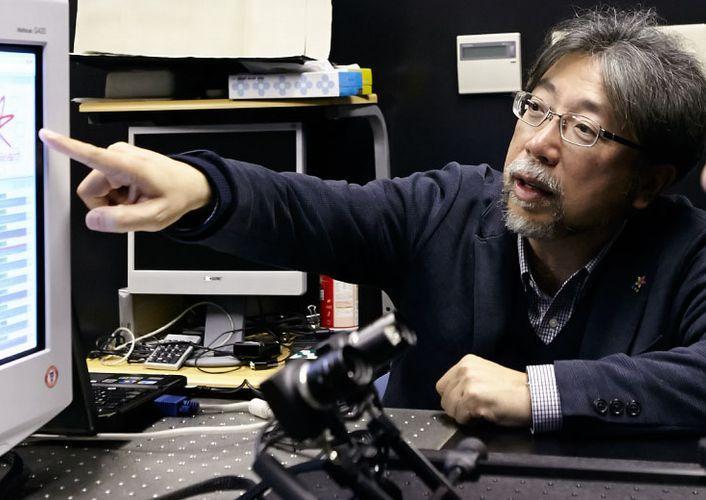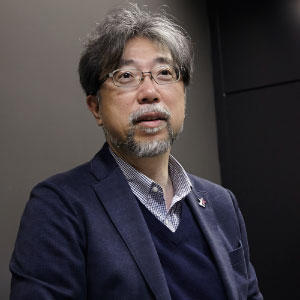- TOP
- Cutting-edge Research and Social Contribution
- Cutting-edge Research
- Numericalization of human affective evaluation evoked by human visual information, aiming at an automation system for design

Numericalization of human affective evaluation evoked by human visual information, aiming at an automation system for design

SHINOMORI KeizoSHINOMORI Keizo
- Specialized field
Vision psychophysics, color engineering, affective information processing, color universal design, brain science, and human information processing
Clarifying human visual information process by psychophysics methodology
How do humans process visual information? Professor Shinomori measures the human visual function by means of a psychophysics method based on actual human perceptual experience, without obtaining direct responses to an external stimulus such as eliciting a nerve response by physiological method or by electrodes, and elucidates it empirically.
Prof. Shinomori says, "In psychophysics, we can analyze the activities of living human neural networks, in a live scenario, using psychological (perceptual) responses. That is a major difference between psychophysics and neurophysiology, which mainly extracts local cell responses."
Prof. Shinomori shows various physically-controlled visual stimuli to experiment collaborators (observers) and asks them to identify color and brightness so that he can deduce some visual principles by combining the physical conditions of the visual stimulus with the human responses. Specifically, he has studied elements such as: 1) the difference in visual response speed induced by various brightness and color of stimuli; 2) the color perception of color deficient people and the elderly; and 3) brain activity during visual information processing. His studies have produced numerous new findings.
Prof. Shinomori continues, " I used to be a poor talker and not good at explaining things in words. That's why I chose to study physics: everything can be expressed by mathematical formulas. But theoretical physics was too big or too small in scale, so I started to think I want to study on a scale a little closer to that of humans. I was also interested in the notion that people cannot be expressed by mathematical formulas. Elementary particles can be expressed by formulas, but human nature cannot. I was curious about that."
He chose the world of vision psychophysics for his master's studies and he has been following that path ever since.
From "How do you see" to "How do you feel"
Prof. Shinomori has recently been focusing on information processing research regarding affective evaluation (KANSEI).
He explains, "The ability to see colors, and what colors a person can see, are at the level of perception. However, how the person feels when he/she looks at something is at a little higher level, a type of brain activity. Human vision has been studied for a long time and many things have been clarified, so I would like to utilize those outcomes to step into the realm of human affective evaluation. Currently, the practical aspects of general design with consideration of the human sense of vision have been developed by professional designers, but design specifically for people with color-vision deficiency is actually quite difficult. I am currently conducting research to make a new index that will clarify that issue."
In past research on the affective evaluation to visual objects, there appeared to be numerous comments that described how people tend to choose one of good designs using just their own sense. Meanwhile Prof. Shinomori has been conducting quantitative evaluations by expressing affective response in mathematical formula, and trying to create an easy evaluation axis when people judge the affective evaluation to the objects using their sense.
One of the specific research themes Prof. Shinomori is working on is analysis of the influence of the positional relation of two different color panels on visual attraction in an overall stimulus. He asks observers to look at many arrangements of color panels and compare the difference in the degree of prominence of the entire arrangement in each pair. From the result, it's possible to identify the interaction between color panels and thus verify the regularity of effect of color arrangement.
Prof. Shinomori says, "If we can quantify this result, it will help to arrange colors to match an individual's taste for color strength when they make things. Traffic signals and signs require an extremely high degree of color intensity, but if such strong colors were everywhere, all the time, people would get tired just from seeing them. So there is a need for a balance of colors in the townscape. However, so far work with color balance has only been done by intuition. That's why I would like to make a model of color balance using mathematical formula so that everybody can do color balancing.
Another theme that Prof. Shinomori has been focusing on recently is elucidating the difference in feelings between ordinary people with color vision and people with color vision deficiency when they see a fashion image with certain colors. The way people perceive colors is not uniform: there are people with color vision different from the normal trichromatism due to congenital factors, referred to as color vision deficiency (color weakness). Since such people have weak red and green responses compared to trichromatic people, their impressions of various colors in fashion may be different. Prof. Shinomori measured impressions of a fashion image and analyzed how those impressions differ between those two kinds of people. That research was conducted using Variantor, a dichromatic color vision deficiency simulator, which Prof. Shinomori jointly developed with Toyohashi University of Technology in 2007.
It turned out that when people wear Variantor®, which was invented by Prof. Shinomori and Visiting Professor Nakauchi (Professor in Toyohashi University of Technology) the color intensity became smaller for red and green fashions and the impression was significantly different. For yellow and blue fashion, there was almost no change, but it was discovered that orange fashions might look similar to yellow while purple fashion might look similar to blue, so the research team was able to capture a subtle impression change.
Prof. Shinomori explains, "In the present situation, even after the design image is decided, the design target is achieved by applying each designer's sense. Designers think hard about design concepts to create impressions, for example, 'airy' or 'for young people.' This research allows us to assign numerical values when we look at a design, so it could be possible to create designs by assigning numerical values. Now I am working to create a system where we can input some numerical values which correspond to some images, and a design corresponding to those values will be generated automatically. It is extremely difficult but that is what I am trying to achieve.
Expression in mathematical formulas creates the potential for great ideas
There are very few researchers in the field of visual psychophysics, compared to other fields. "That may be because this field works with extremely complicated ideas and experiences." Prof. Shinomori feels it is worthwhile and challenging to pursue his research themes deeply over the long term, from an initial concept to the production of new knowledge. For example, changes in vision due to aging is a research theme that he has been pursuing continuously since he began work as a researcher, almost 25 years ago.
"My nature is such that when once I start research on a new theme, it becomes deeper and deeper and I cannot stop until a conclusion appears," he says, smiling.
It seems that thorough and tough working style of Prof. Shinomori has yielded a number of such achievements.
"The interesting part of this research is that the appearance and visibility of colors become numerical values. I love to express things with mathematical formula, so this work suits me well. When a phenomenon becomes a numerical value, it can be understood as a quantity, so it becomes easier to compare things. Then we are able to deal with things in ways that were not possible before. I love that."
Expressing things in mathematical formula inspires us to look for new possibilities. What does Prof. Shinomori see beyond his current research?
"I think that if this research progresses, it will ultimately go towards artificial intelligence. This is somewhat close to achieving automated affective evaluation expression. Like a human brain's neural circuits, if the process of Deep Learning which is currently attracting attention as an artificial intelligence technology capable of hierarchical recognition can be formulated mathematically, I have an intuition that may take us even closer to "real" artificial intelligence. I think that is a part of goal that artificial intelligence cannot achieve, so I would like to make a system which compensates for AI limitations in that area."
As Prof. Shinomori concluded the interview, it was easy to see that he is a strongly dedicated person.
